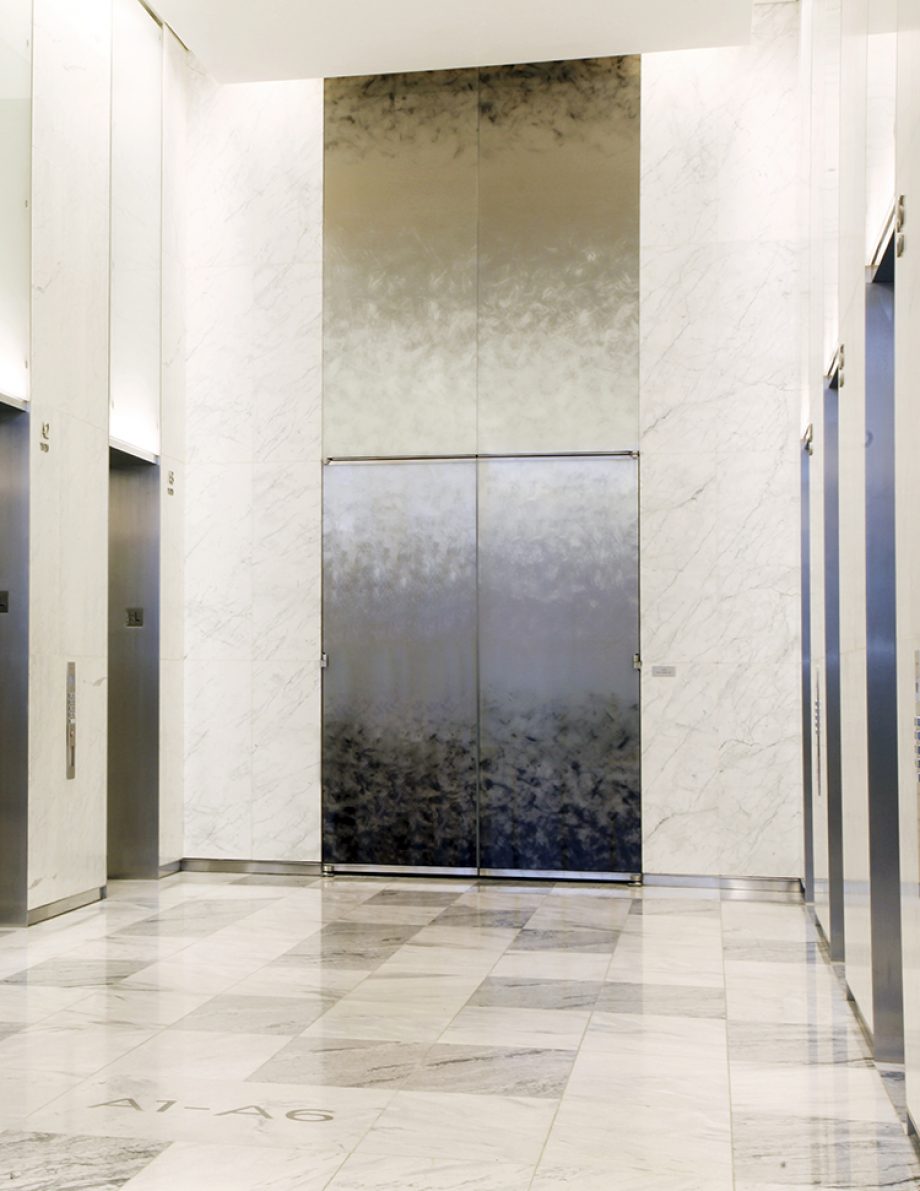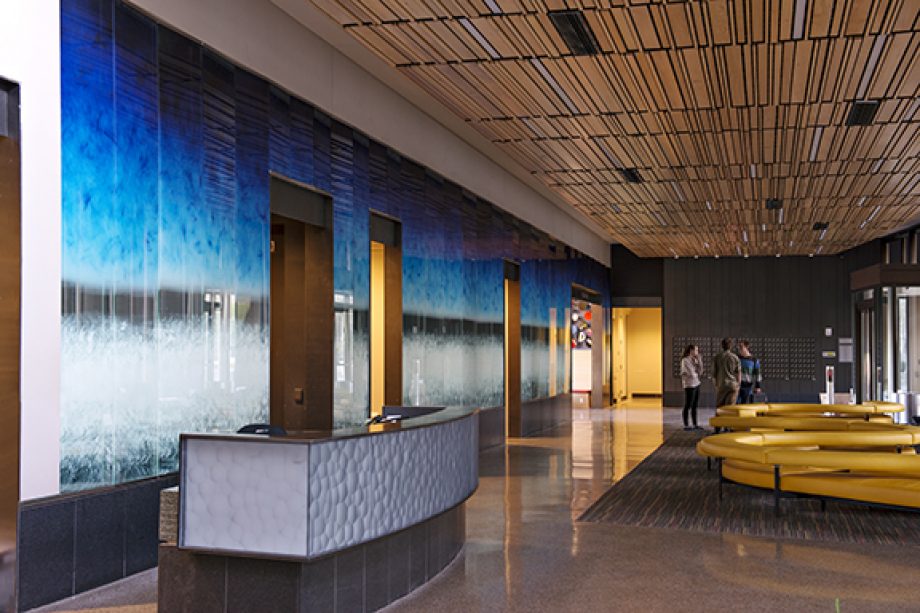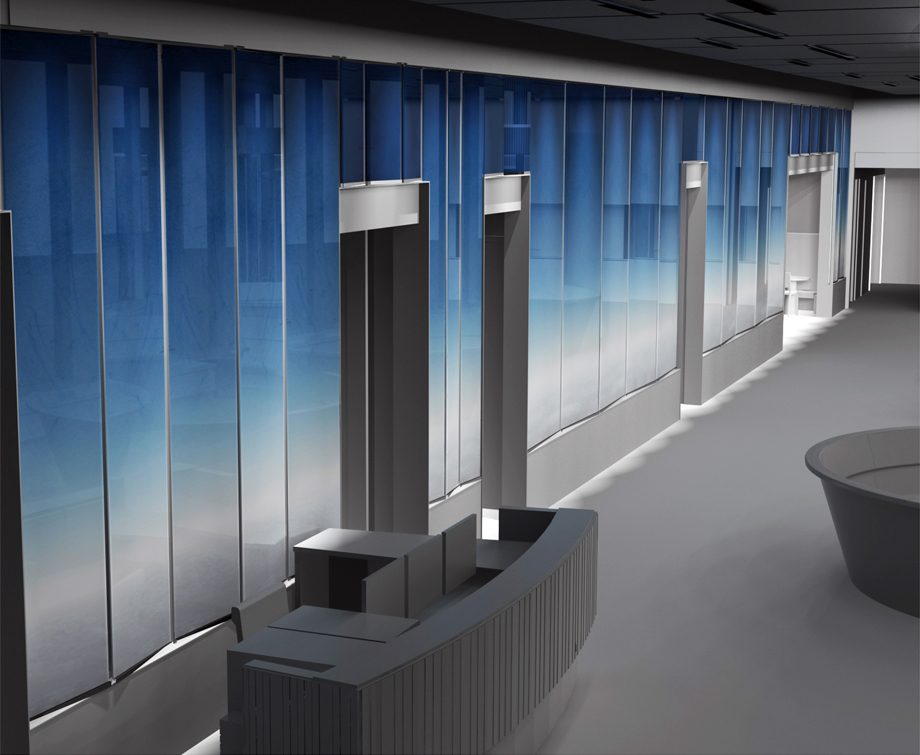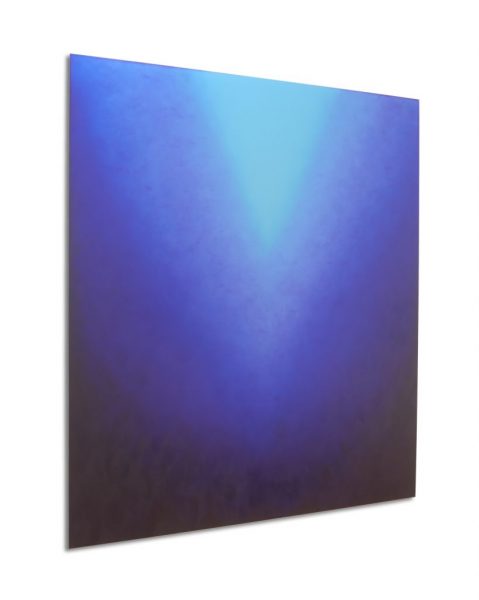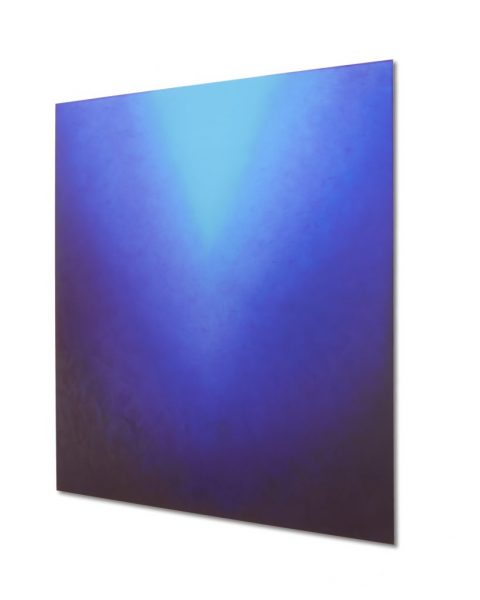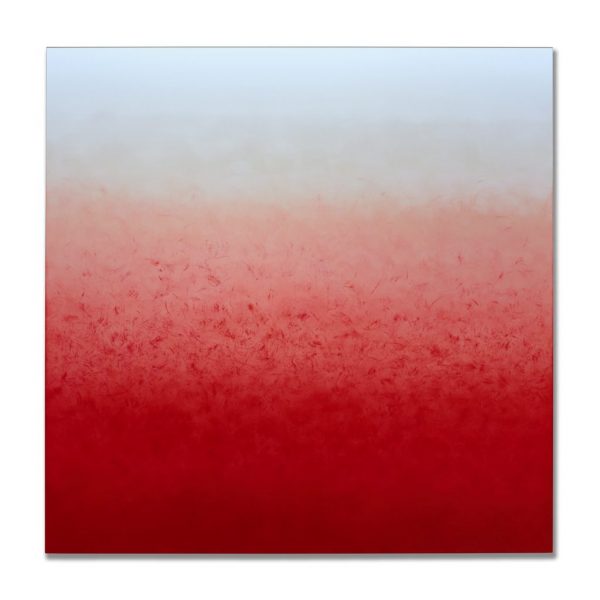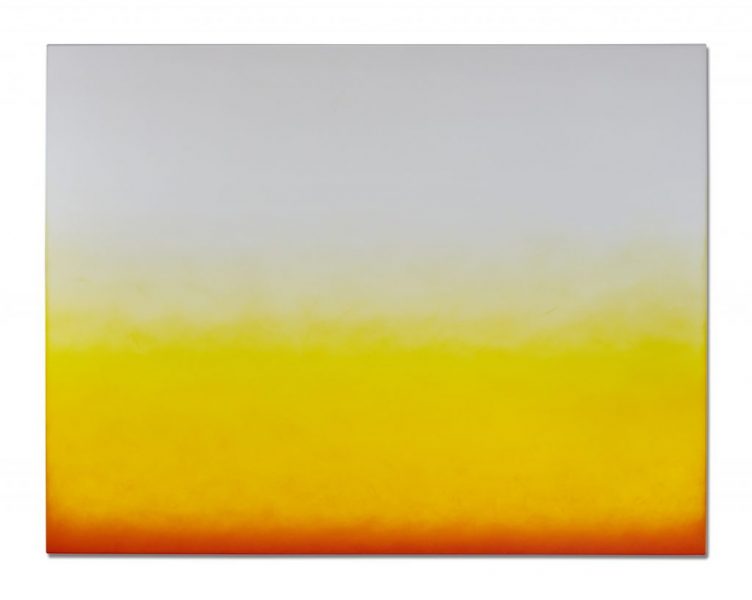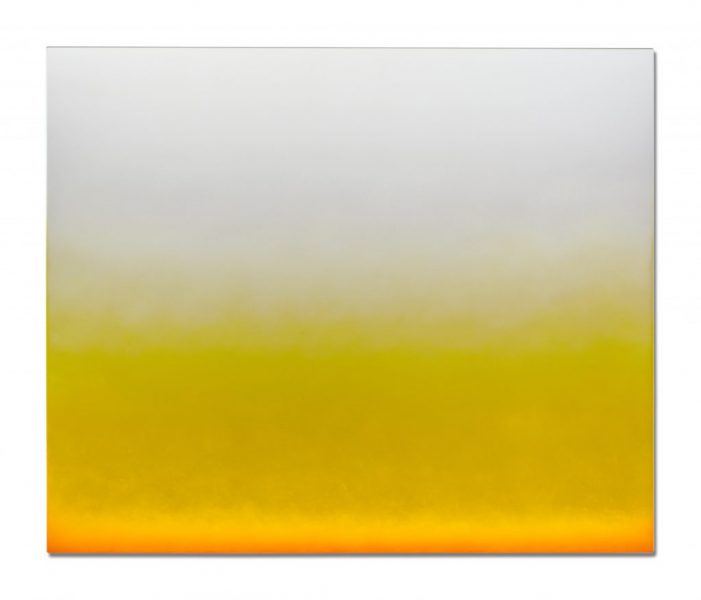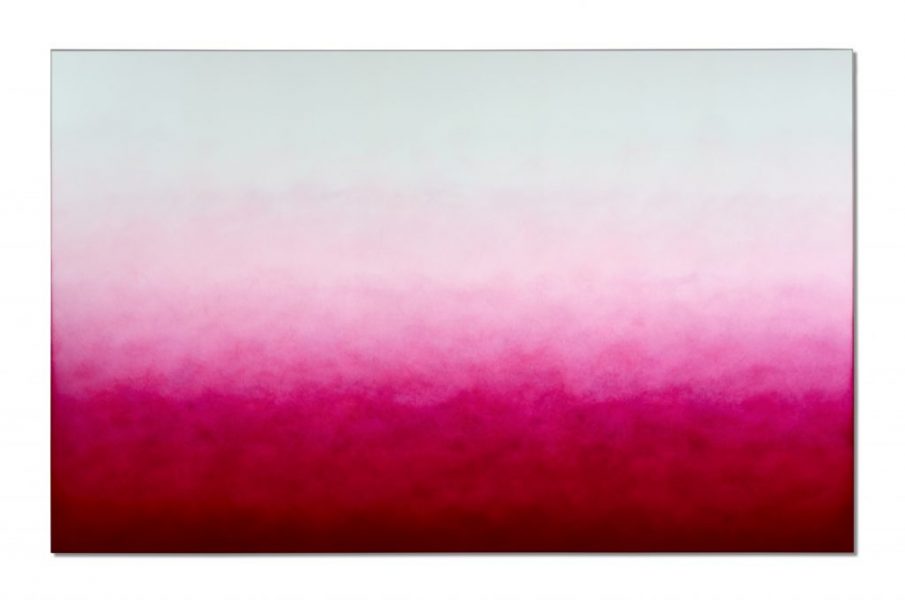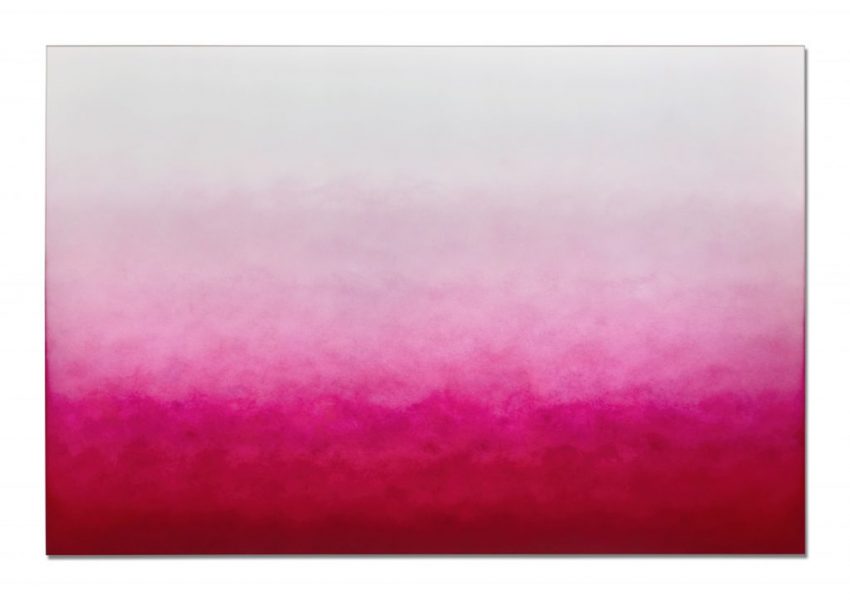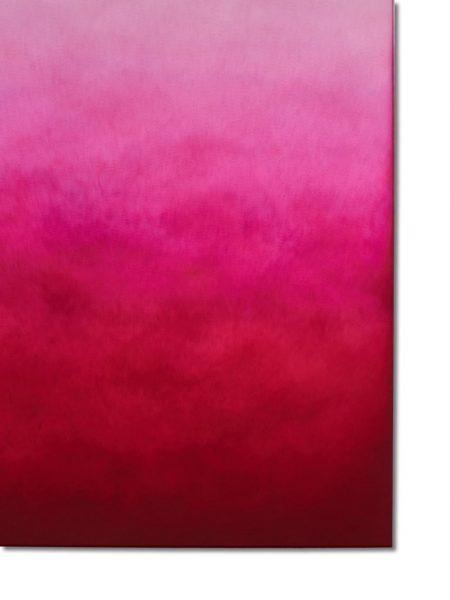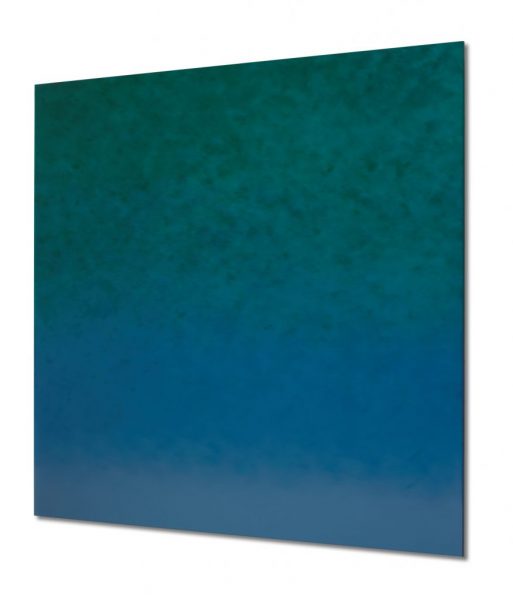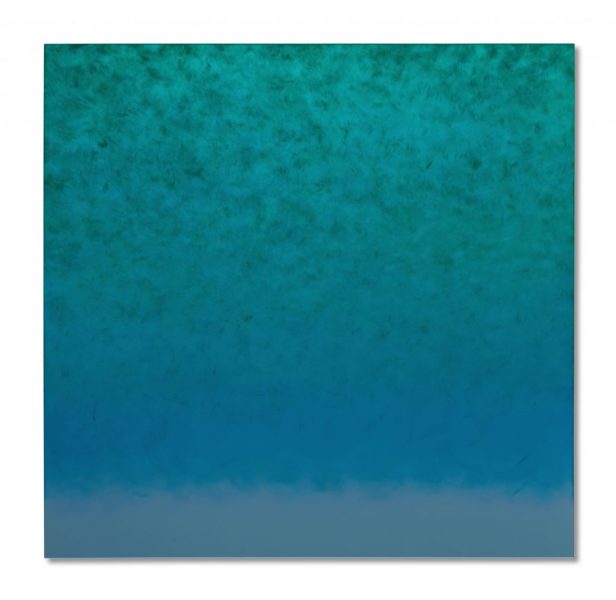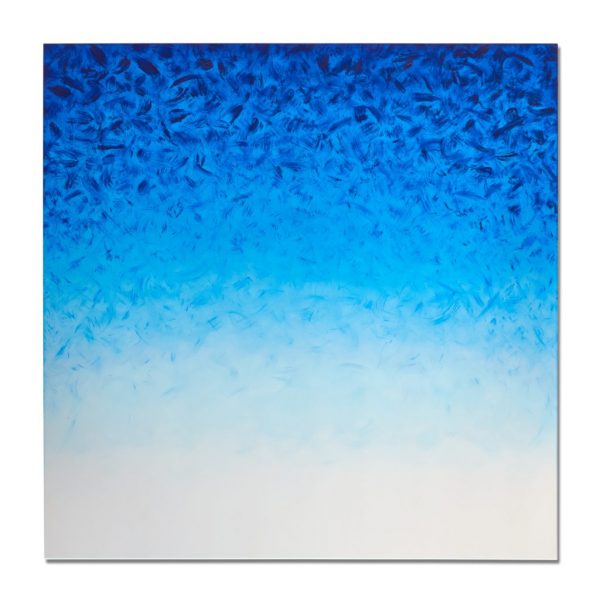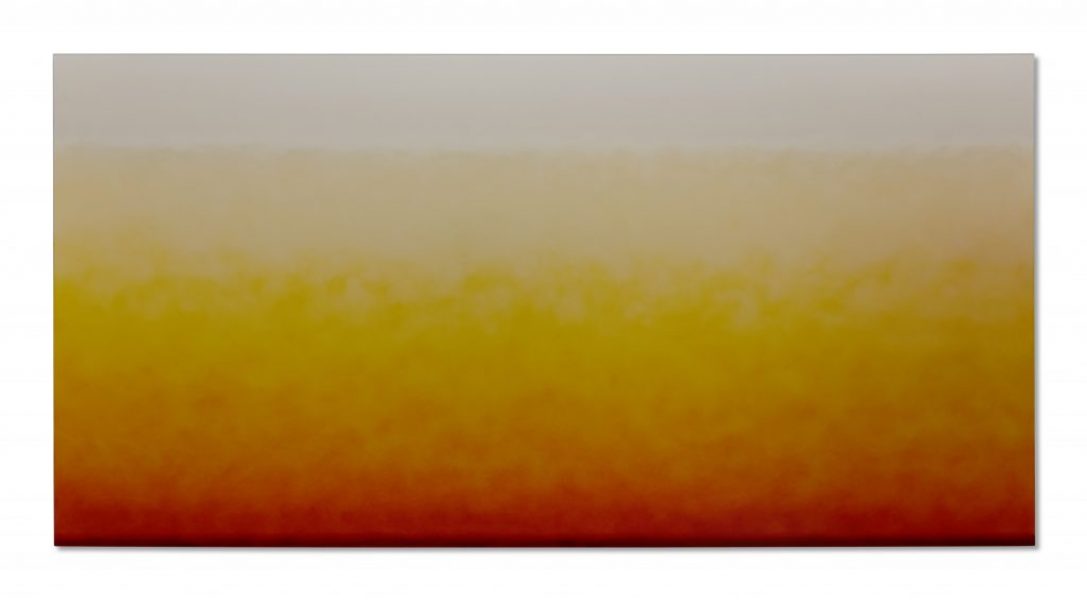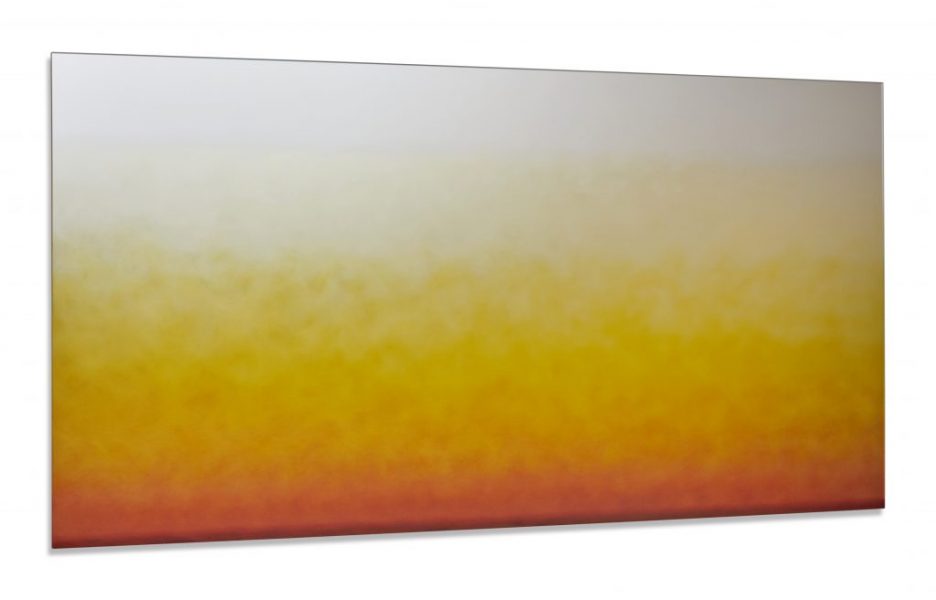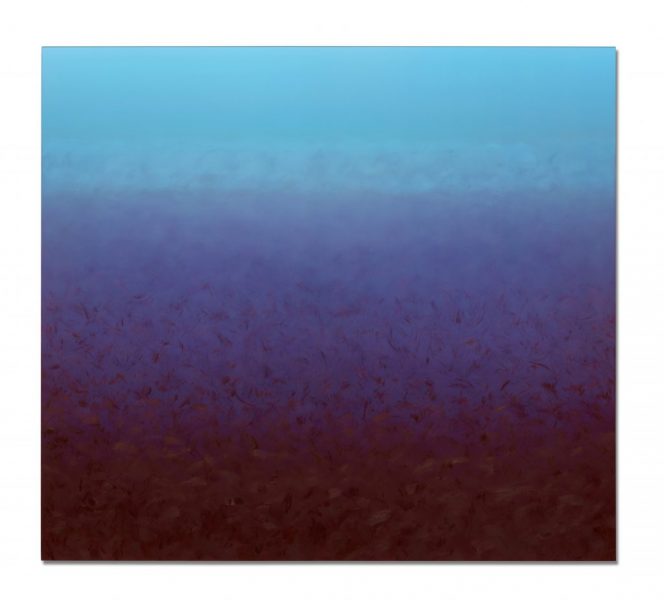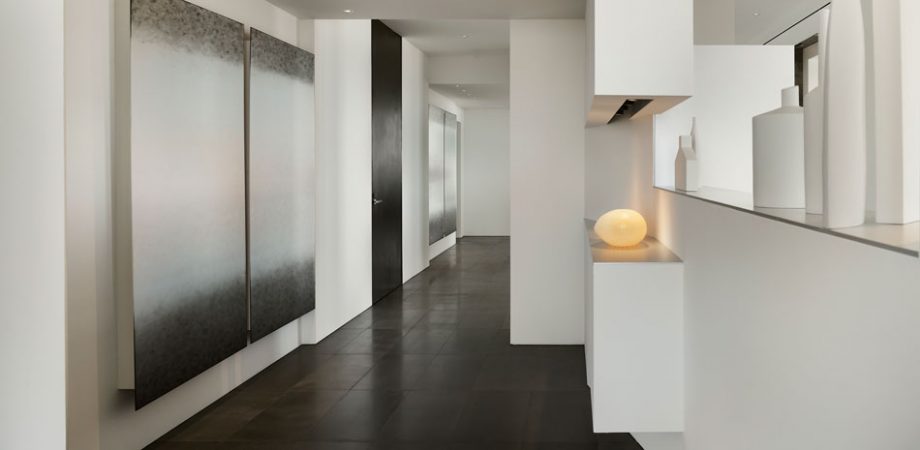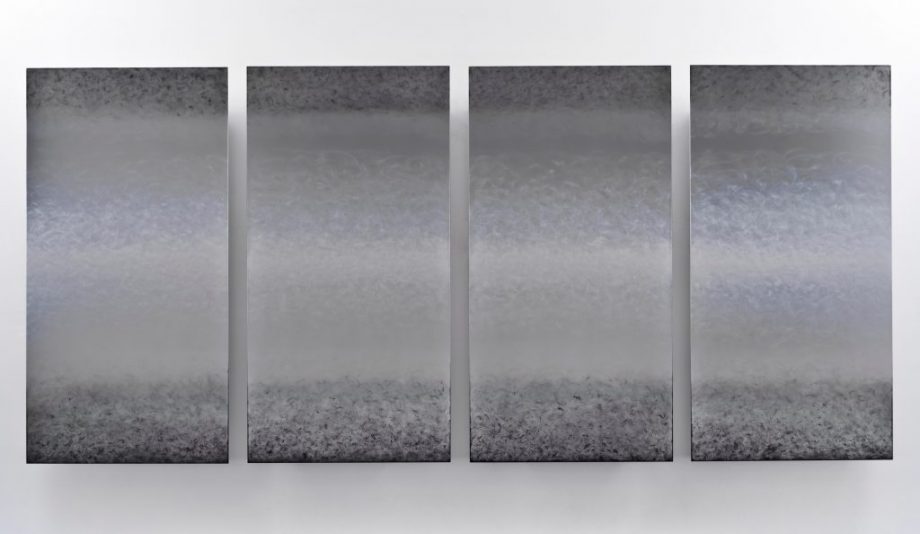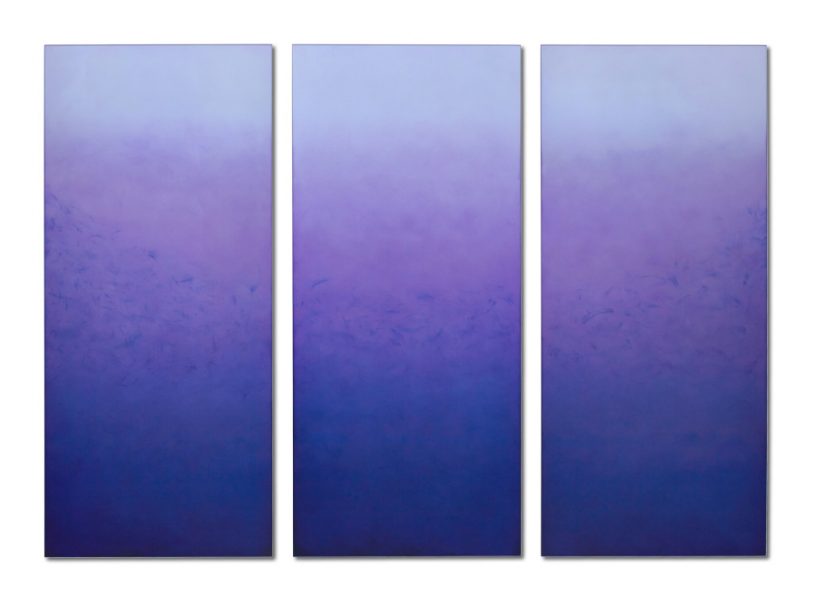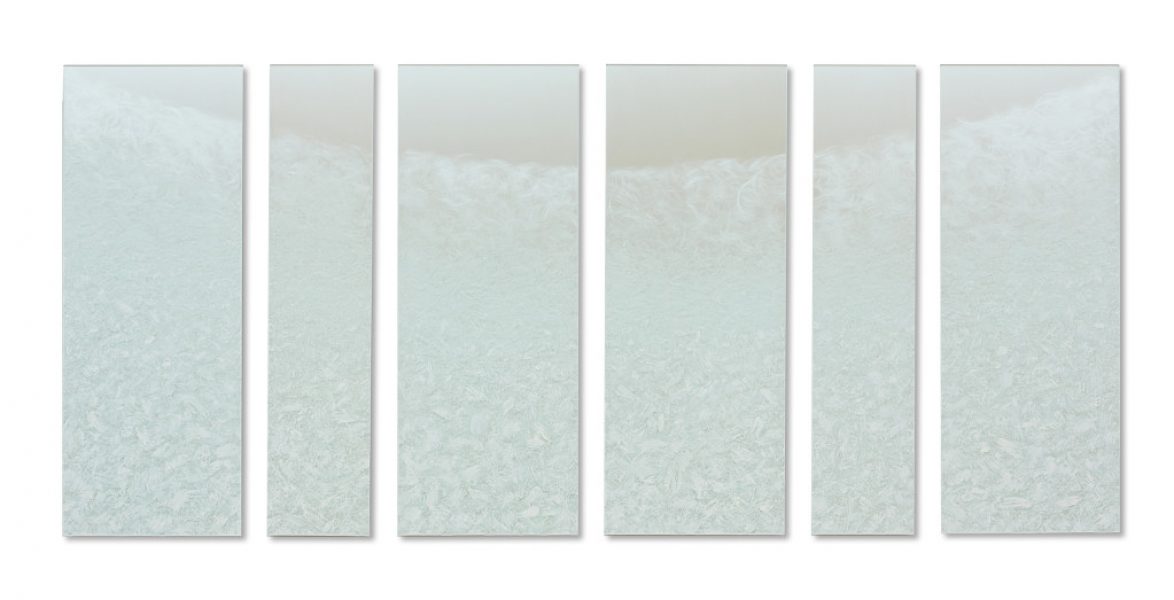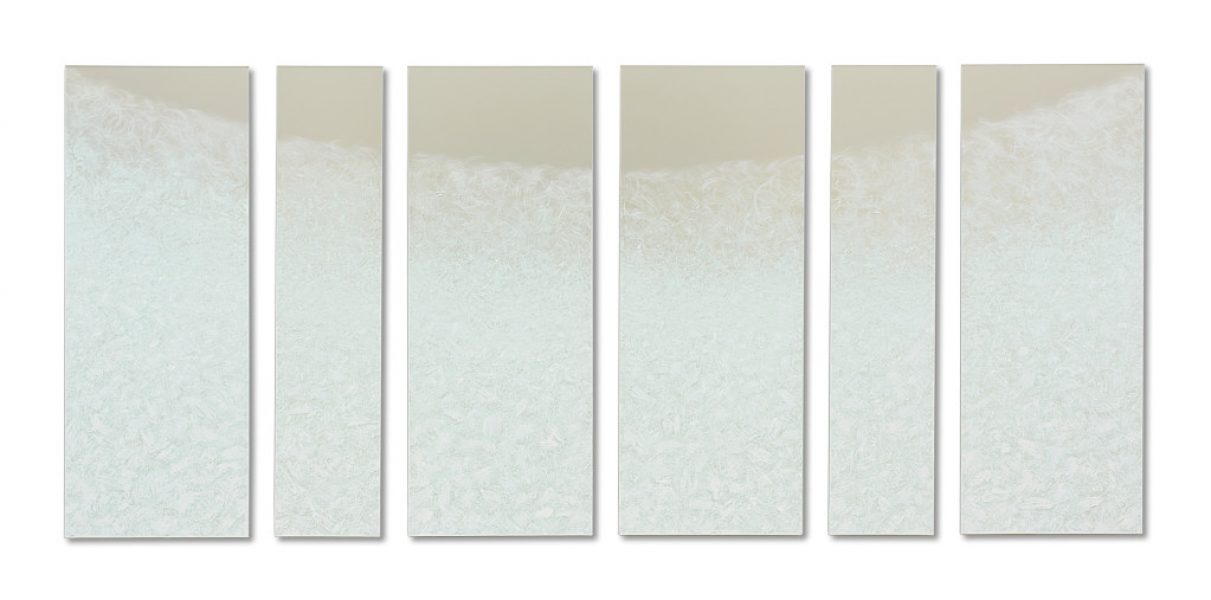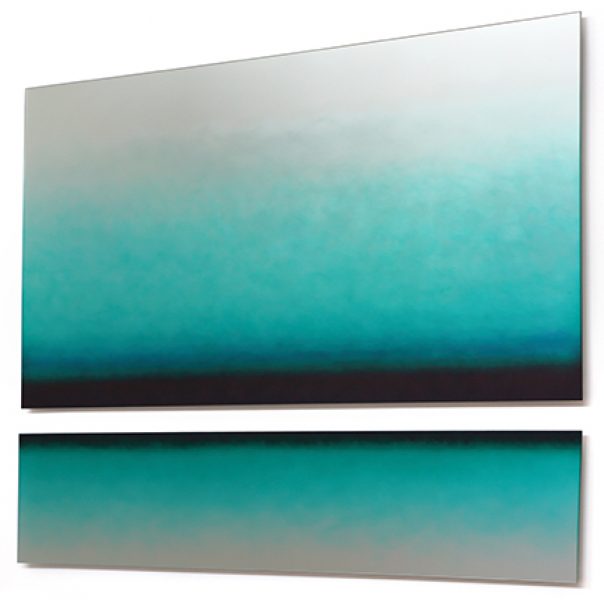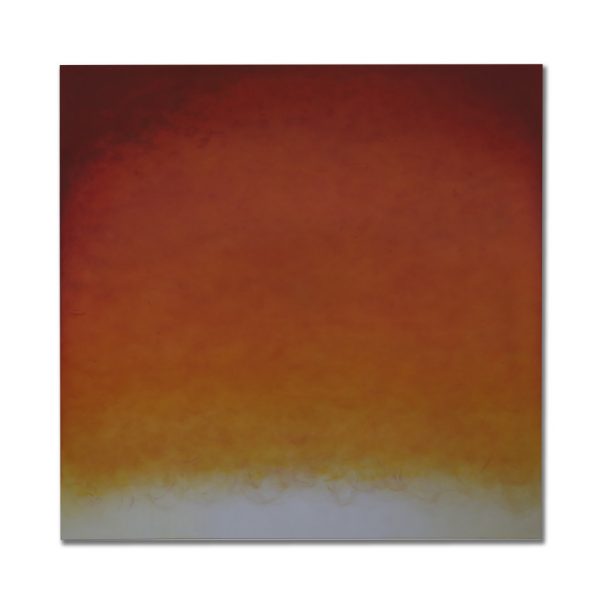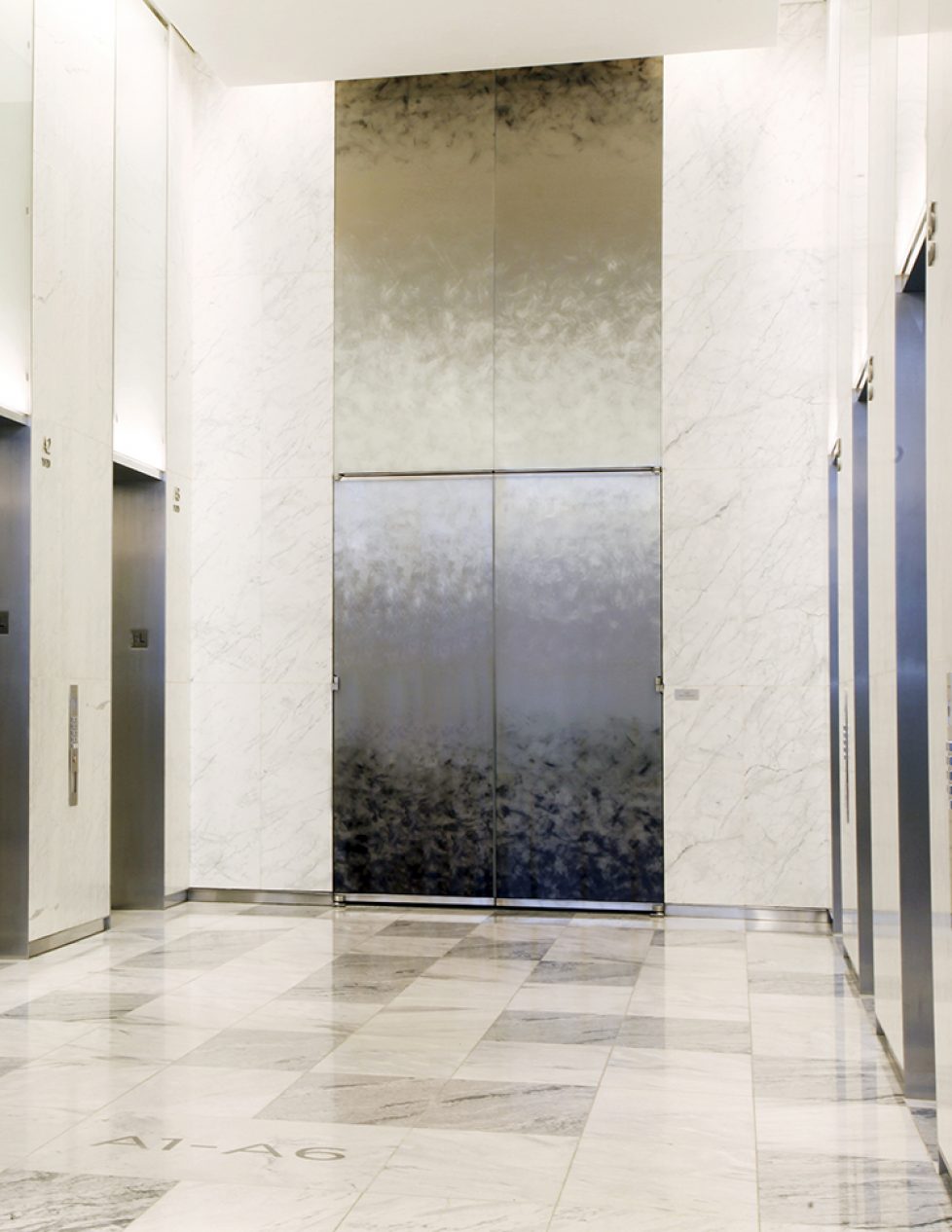
Posts by :

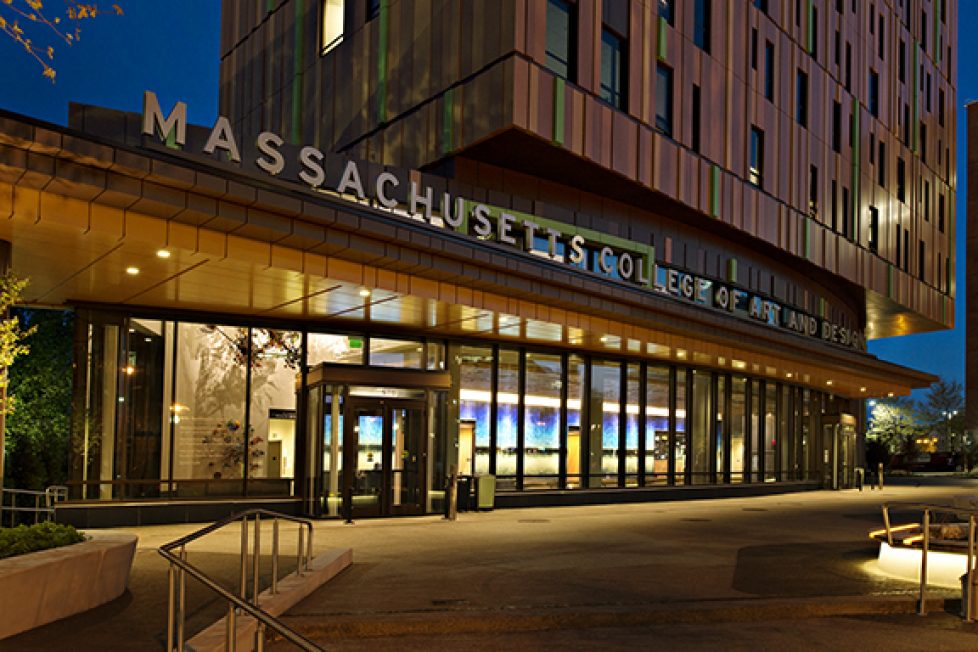
Kairos at MassArt

Aver 3
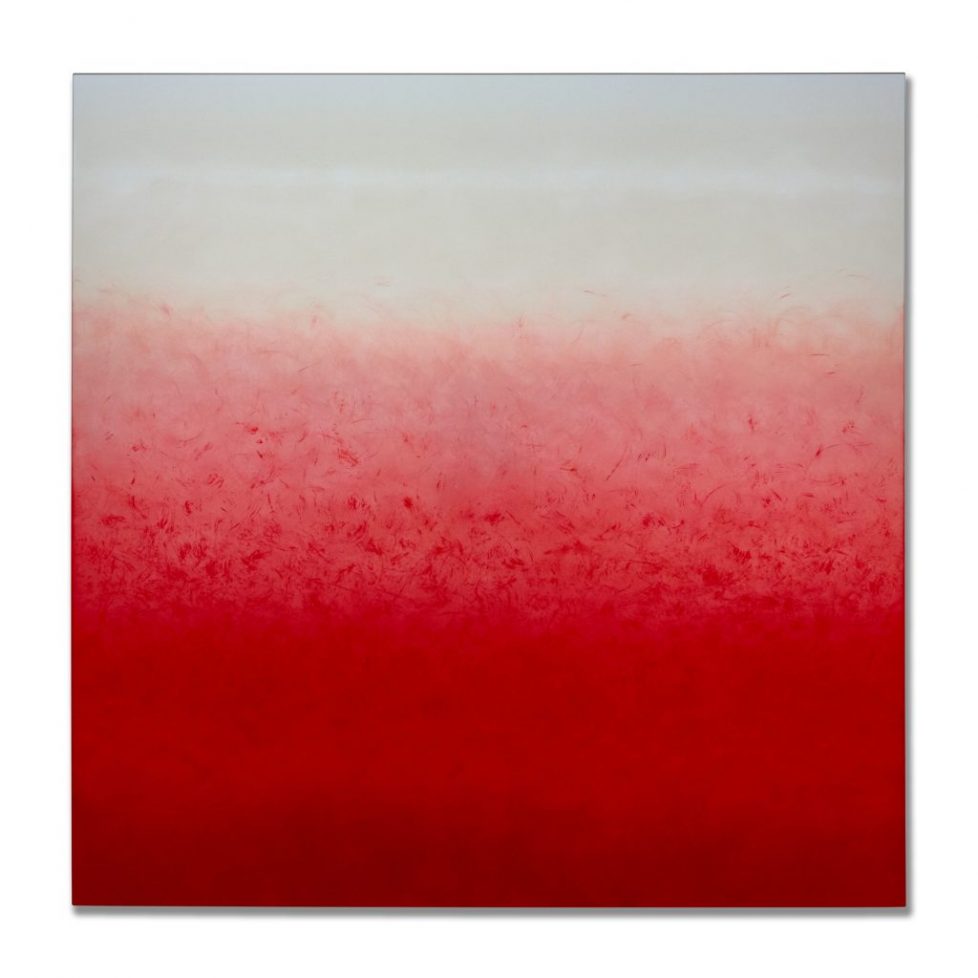
Carmen
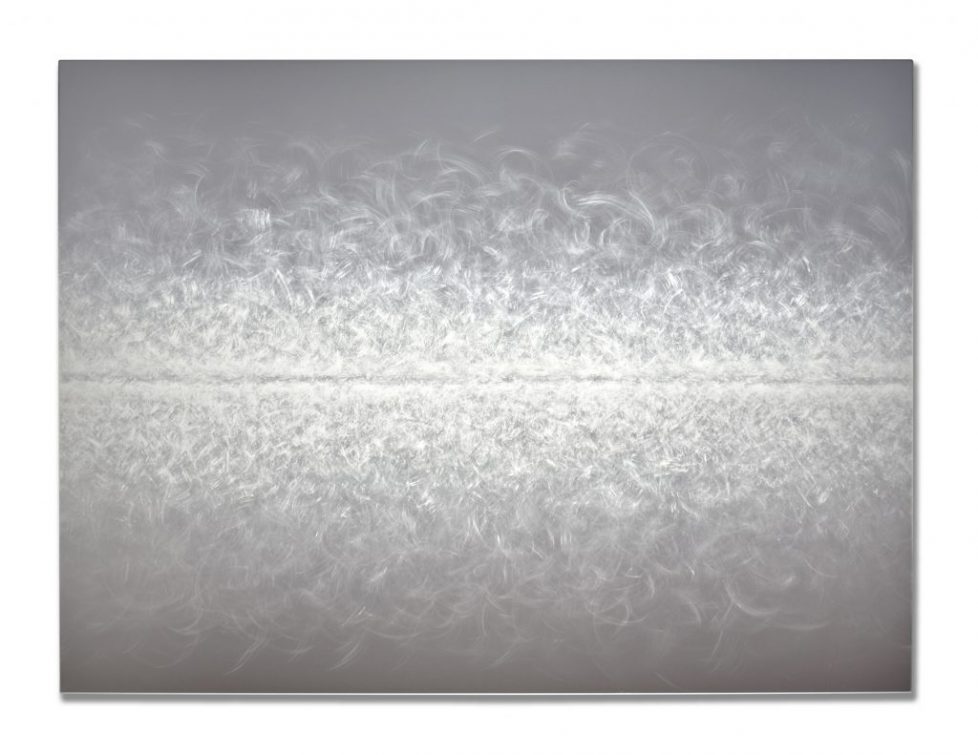
Aphros
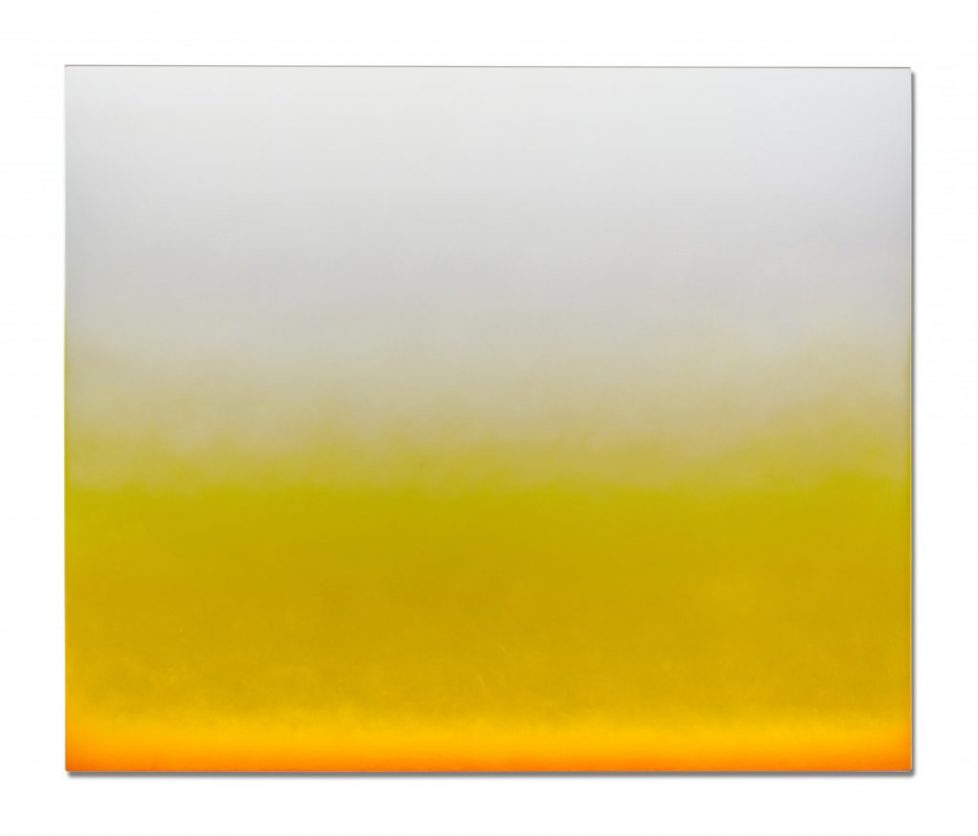
Gleam
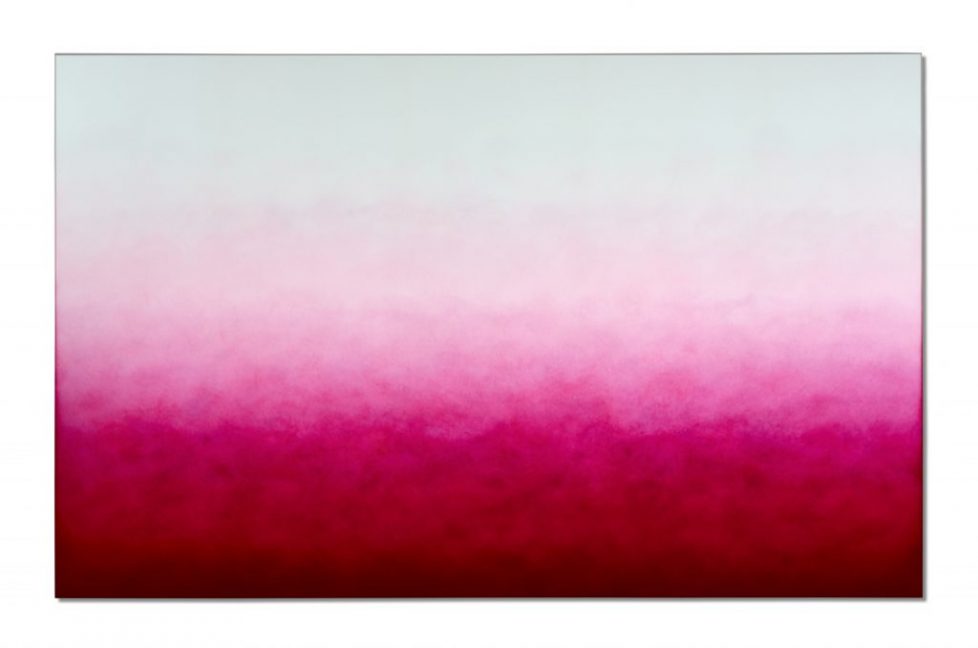
Arose

Arise 2

Lucet
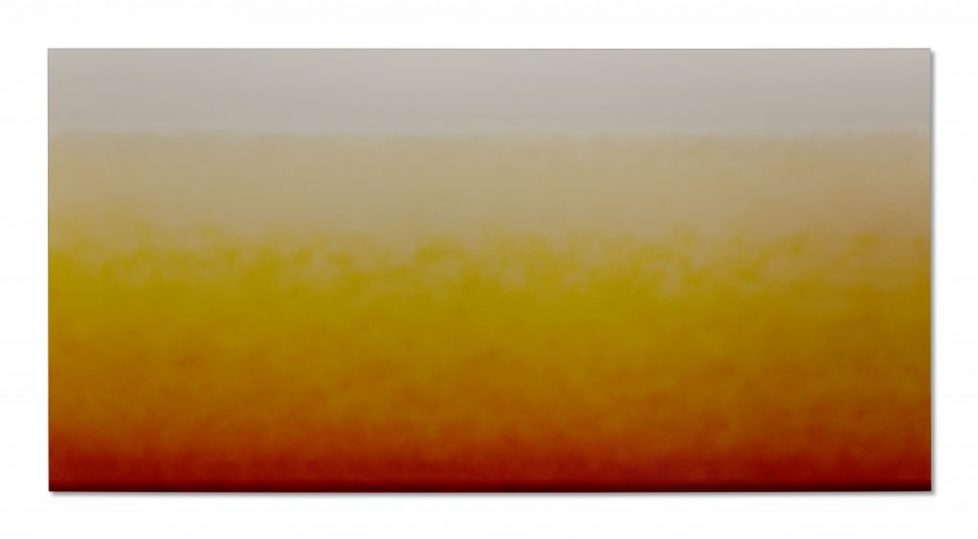
Ardor 2

Divum
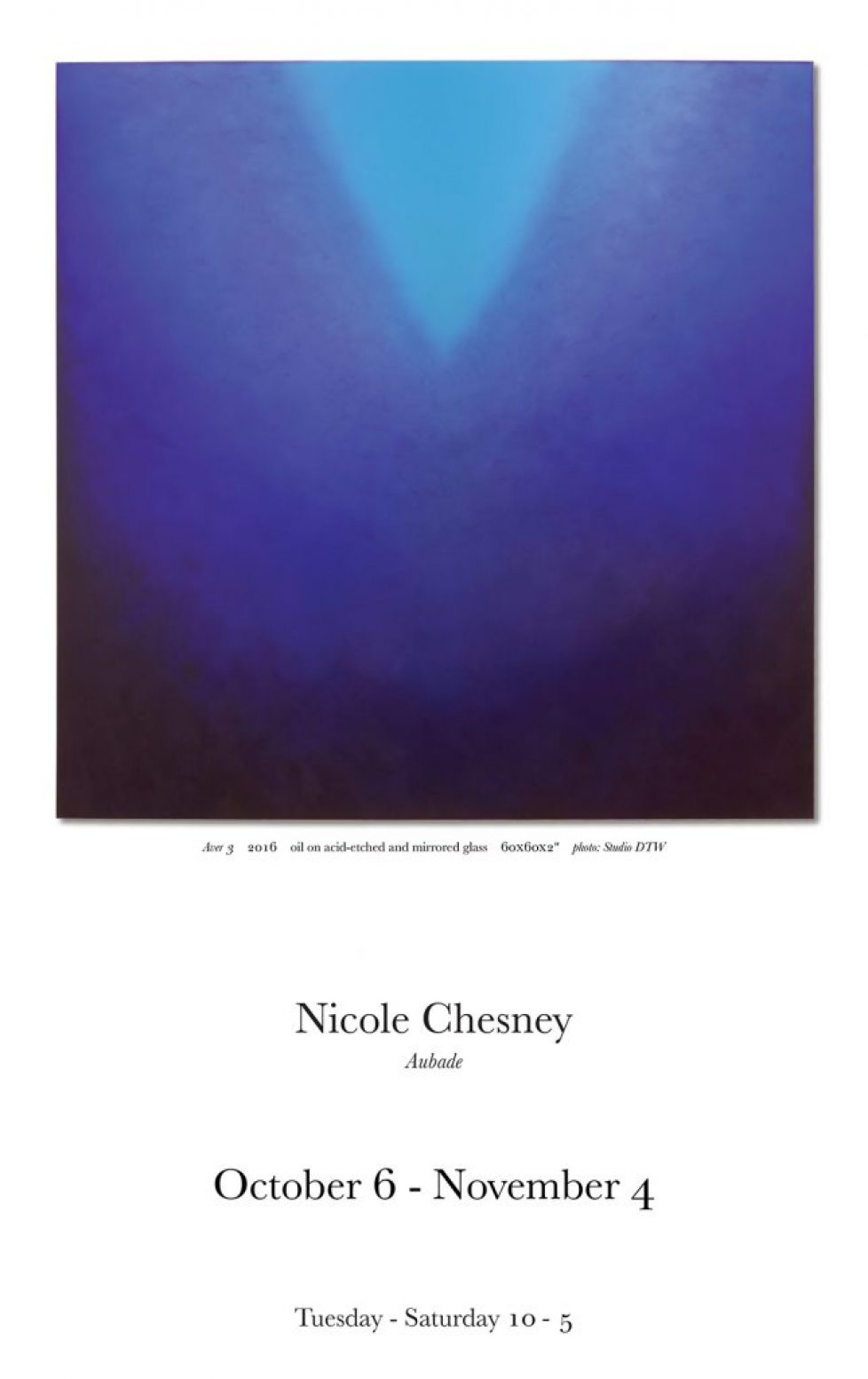
Aubade at Gallery Naga
Nicole Chesney’s Aubade at Gallery NAGA, Boston
October 2017

Gallery NAGA is pleased to present our second major solo exhibition of paintings by Nicole Chesney.
Nicole Chesney: Aubade is on exhibition from October 6 to November 4. A reception for the artist and the public will be held at the gallery on Friday, October 6 from 6 to 8 pm.
Chesney is an abstract painter who uses flat sheets of glass as her surface. She began her non-traditional work with glass after having studied at the California College of Arts and Crafts, the Massachusetts College of Art and finally the Canberra School of Art at Australia National University. Never interested in sculpting glass, Chesney used the medium as a jumping off point for her paintings. After taking classes in jewelry and print-making, she explored the material of glass for its ability to manipulate light. “I didn’t study painting,” says Chesney. “Like jewelry, my love affair with glass has to do with [its] precious, desirous qualities that really boil down to light.”
Glass, with all its transformative qualities, is a surface onto which Chesney can add, subtract, and move oil paint around; colors are reflected in a way that canvas or paper doesn’t allow for. Seen from one angle, her painting surfaces are matte and brushy, seen from another angle, they are reflective and elusive.
Chesney loads the surface with paint, then wipes it away to reveal the layers beneath a process done multiple times to create sheer layers. The glass itself is etched so that it has a tooth, or uneven quality that can grab and hold whatever oil is applied. Chesney uses her layers of feathery, light brushstrokes to create smooth gradients from thick to translucent and from light to dark. Her brushstrokes, more confident and freer than ever, leave traces of circular or criss-crossing paths on the surface of the glass.
The colors (formed by oil paint) of Nicole Chesney’s paintings, — whether warm tones of purple, peach, and red, or cooler tones of blue, green, and white—sit on top of the glass surface. Because they are mirrored, however, the colors bounce back and appear as though they are coming from within the glass, giving each painting its own gentle vibration.
Chesney has entitled her show at NAGA Aubade, a French word meaning a poem or piece of music appropriate to the early morning—a dawn serenade. One could just as easily see the work as an evening sunset—splendid as the dusk.
Images of all work on exhibition can be seen at gallerynaga.com.
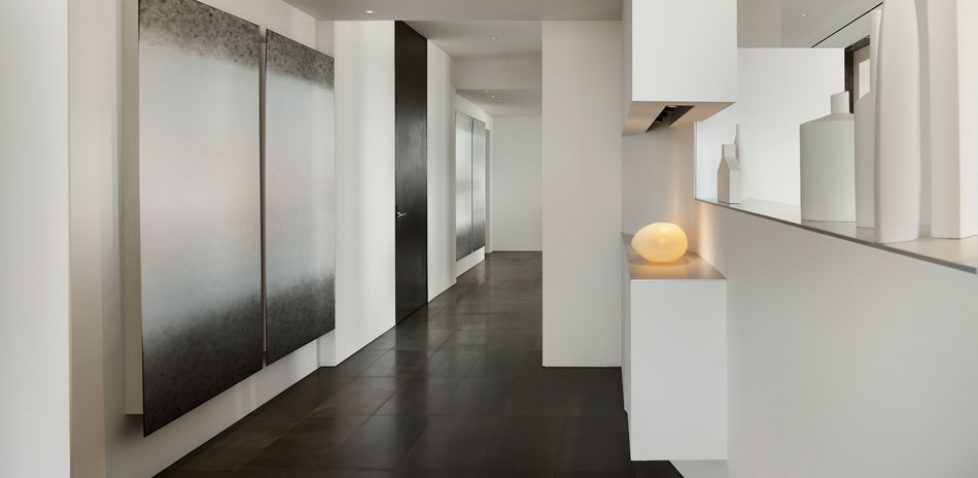
Buoyant in Private Penthouse
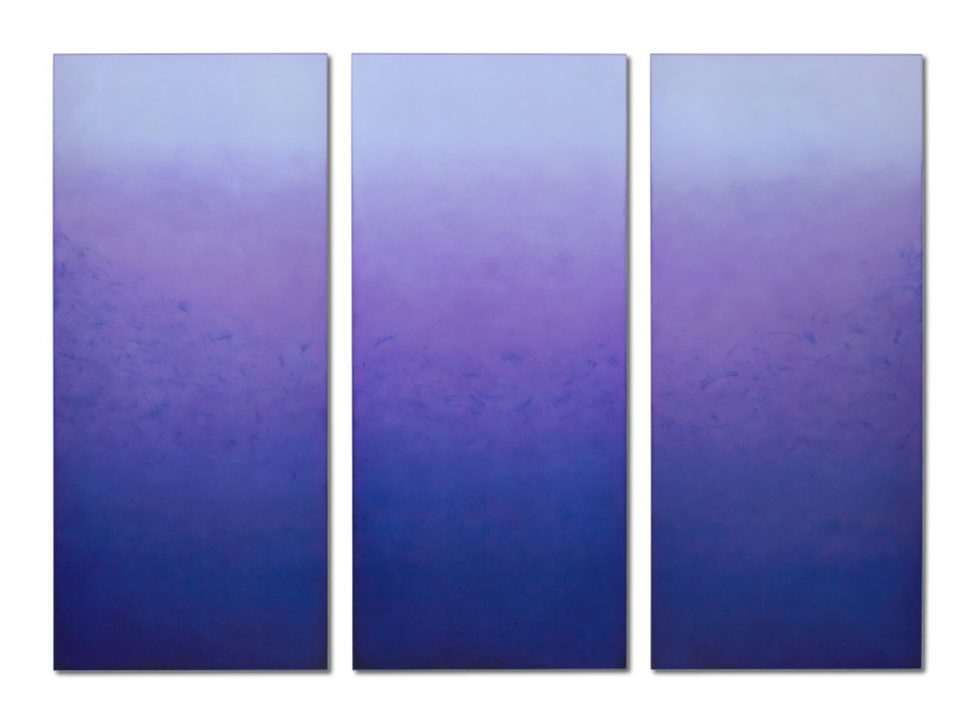
Votum
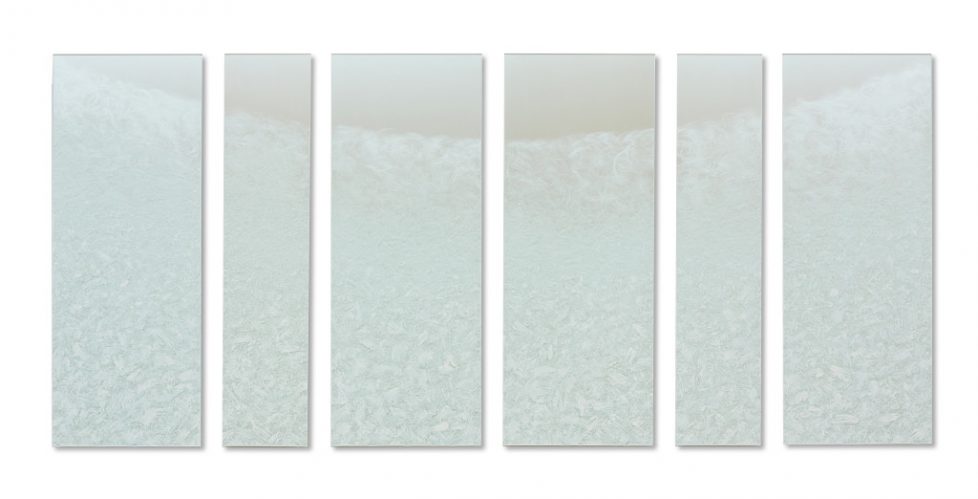
Somnio

Altum

Aver 2
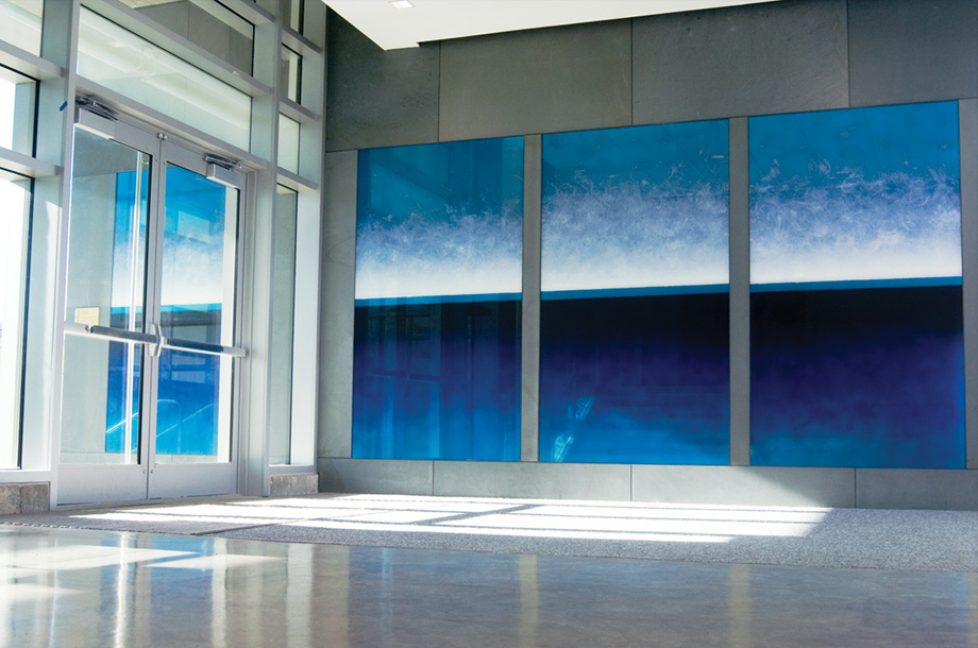
Sample Press Copy
Nicole Chesney’s Welkin, a large, four-panel glass work, permanently installed in the Nulman Lewis Student Center at the Wheeler School in Providence, is testament to the fact that no material is able to manipulate light the way glass can.
Chesney, a Providence glass artist, is known for her ephemeral paintings depicting water and sky on mirrored, acid-etched glass. Her works, often assembled from more than one pane, are not literal images of land- or seascapes. Rather, they act as an abstract of a place, intended to suggest a mood. They succeed by conveying the effect of glaring sunlight reflecting off the sea on a hot, steamy summer’s day or suggesting the solid nothingness of dense, wool-like fog hanging heavy in the air.
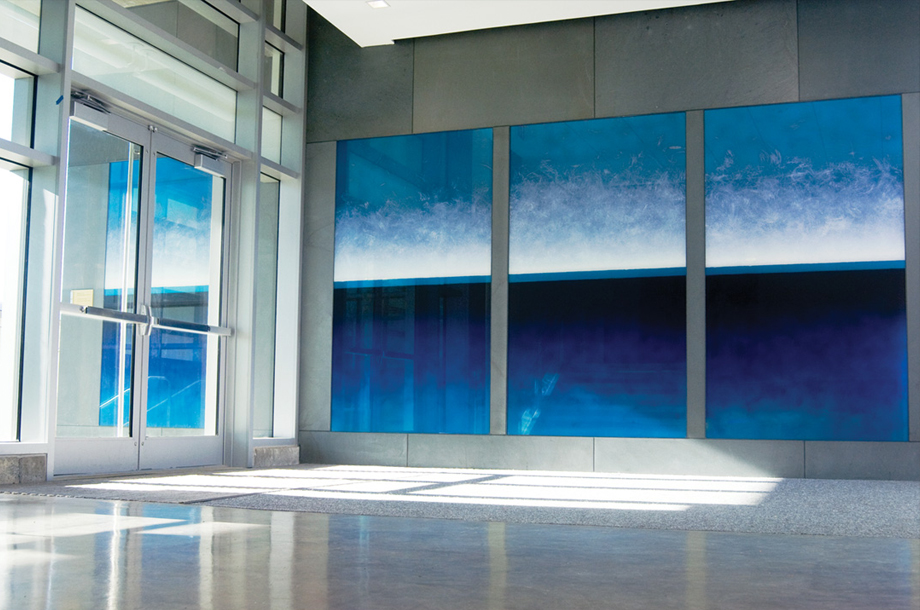
Chesney’s paintings inspire awe, drawing viewers in and seducing them to linger and relish the serene moment. They provide a place to escape, to lose oneself while savoring the immense silence and solitude. This also holds true for Welkin (which means “the vault of heaven”), completed by Chesney last fall as part of the Wheeler School’s public art initiative. The piece takes full advantage of the reflective qualities of the glass, enlivening the new gateway to the school’s dense campus. Set flush within a bluestone wall, the deep shades of cobalt blue and brilliant turquoise in the glass create the illusion of a panoramic view, complete with a fluffy, white cloud mass; a light blue sky; and a thick, dark horizon. No photograph can reproduce the light radiating from the panels, glowing as if the whole wall is backlit, reminiscent of an illuminated swimming pool at night.
For Chesney, who exhibits her work internationally, Welkin represents a career milestone. Not only is this the largest piece she has ever made (eight by twenty feet), it provided her with the opportunity to experiment with an architectural glazing process-in which printed layers of plastic are laminated between two sheets of glass-in order to generate the image that complements Wheeler’s modern addition.
—Martina Windels

Nicole Chesney mentioned in the Wall Street Journal
Nicole Chesney Mentioned in the Wall Street Journal

by Peter S. Green
September 21, 2014
There was a time when glass was a craft. But in recent years it has become something more: an established art form, and an attractive—and affordable—investment.
“Art glass is a great way to begin collecting art because there is so much available at so many price points,” says Carina Villinger, head of 20th century decorative art and design at Christie’s.
Since the launch of the Studio Glass movement in the 1960s, glass has slowly crossed the species barrier from craft to fine art. Today, examples of glass art include bright colors and arresting shapes, works that resemble paintings in glass, and objects both strange and familiar encased in glass.
‘Something Higher’
“You’re taking sand, soda and ash, and through fire transforming them into something higher,” says Douglas Heller, a partner in Heller Gallery in New York City. A successful glass artist needs both the inspiration of an artist and the skill of a craftsman to make a successful piece of art glass, Mr. Heller says.
“Right away, that separates out the dilettantes,” he adds.
Harlan Fischer, president of the Art Alliance for Contemporary Glass, a group of leading collectors, says what attracts collectors to art glass is the sense of “urgency” seen in a finished piece. “You can’t just start on your artwork and go eat lunch and come back,” Mr. Fischer says. “You have to continue working it in its molten form to prevent it cracking and shattering.”
Experts in the field agree there are opportunities for collecting art glass at all points on the price spectrum. “Admittedly you have to have some discretionary income,” says Mr. Heller. “But you don’t have to be wealthy.”
Wide Spectrum
Works at the high end of the market have brought auction prices ranging from around $70,000, for the Italian artist Paolo Venini, to $480,000 for a piece by Czech collaborators Stanislav Libensky and Jaroslava Brychtova that was sold in 2007. Glass works by Libensky tend to be massive exercises in geometry—some more than 10 feet tall—that transform the light that passes through them. Blown glass pieces by Lino Tagliapietra, who has fused the techniques of Murano glassworks with vibrant colors of American studio artists, sell for $50,000 to $75,000. His cast glass panels can sell for $95,000 to $250,000.
There are newer artists as well whose pieces fetch prices from $5,000 to $15,000, including Amber Cowan, whose floral hangings use recycled mid-century pressed glass, Norwood Viviano, whose castings map the decline of industrial cities including his hometown of Detroit, and Nicole Chesney, who paints mirrored glass plates evoking stormy skies.
Works by artists who achieve critical acclaim have proved to be good investments. Libensky pieces that sold for $1,200 to $6,000 in the early 1980s are commanding prices 20 to 30 times higher these days, says Ferdinand Hampson, founder of Habatat Galleries, in Royal Oak, Mich. Works by Harvey Littleton, widely considered to be the father of the Studio Glass movement, in recent years were fetching as much as $40,000, according to the Artnet price database, after selling for as little as $600 in the 1970s, Mr. Hampson says.
“The fun part about glass,” says Tina Oldknow, senior curator of modern and contemporary glass at the Corning Museum of Glass in Corning, N.Y., “is that there’s so much going on that’s so different.”

Nicole Chesney in Landscape, abstracted at the Museum of Fine Arts, Boston
Nicole Chesney in Landscape, Abstracted at the Museum of Fine Arts, Boston

LANDSCAPE, ABSTRACTED
August 16, 2014 – July 30, 2017
Eunice and Julien Cohen Galleria (Gallery 265)
A contemporary take on landscape in the Linde Family Wing for Contemporary Art.
This new installation in the Linde Family Wing for Contemporary Art’s Eunice and Julian Cohen Galleria offers a contemporary spin on landscape art. Ten works, including sculptures, paintings, installation, and video art, present contemporary art as the latest chapter in the story of landscape art through the ages, as told by the MFA’s encyclopedic collection. Works include a number of new acquisitions that have never before been on view, as well as new commissions by Jason Middlebrook and Anne Lindberg. Their soaring creations evoke nature’s sublime potential through color and pattern, using the dramatic architecture of the Linde Family Wing to guide their work.
Jason Middlebrook has been invited to paint the largest wall in the Cohen Galleria, which measures 24 by 80 feet. Middlebrook’s signature patterning weds the geometry of modern abstraction with the lines of wood grain to “create a tension between something organic and something man-made.” Another site-specific work by artist Anne Lindberg evokes nature by using only thread and staples. Suspended from the vaulted ceiling of the Linde Family Wing’s second floor, Lindberg’s work soars gracefully above visiting guests. This is the first time Lindberg has created a work installed at this height (16½ feet), allowing visitors to look up through a field of color.
Works from the MFA’s collection that expand the definition of “landscape” beyond the horizon line include chenille beanbag Topia Chairs (2008) by Barbara Gallucci, a professor at the School of the Museum of Fine Arts. Another take on the theme is seen in the playful video, Eating Landscape (2005), which depicts artist Song Dong (Chinese, born in 1966) building an edible tableau that satirizes traditional Chinese ink landscapes.
Working in the legacy of Claude Monet, Spencer Finch’s Shield of Achilles (Dawn, Troy, 10/27/02) (2013), re-creates the light of dawn. He carefully observes and notates the colors at a precise time and location, reproducing them with filtered fluorescent light bulbs. Ghost (Vines) (2013) by Teresita Fernández references nature’s fleeting presence. Layers of precision-cut metal are backed with bright green silkscreen ink that casts a soft green glow around sharp, machined edges—mimicking the pattern of moss. Other works on view in the installation include Two Whites Over Antique Red Over Cadmium Red (2013) by Pat Steir, Garrowby Hill (1998) by David Hockney, Verity (magenta blue), Repose, and Verity (blue green gray) by Nicole Chesney, and Untitled (2003) by Tara Donovan.
On view in the Eunice and Julien Cohen Galleria, Level 2; Hope and Mel Barkin Art Wall; and Michael D. Wolk Art Wall.
More information can be found here.
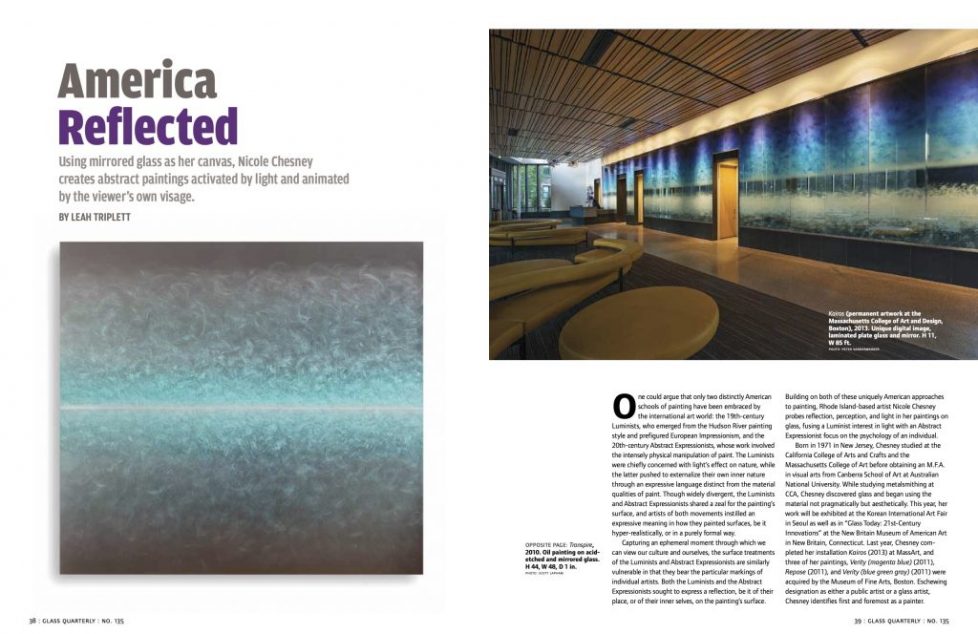
Nicole Chesney’s Luminescence: America Reflected, Glass Quarterly, Summer 2014
Nicole Chesney’s Luminescence: “America Reflected”, Glass Quarterly, Summer 2014

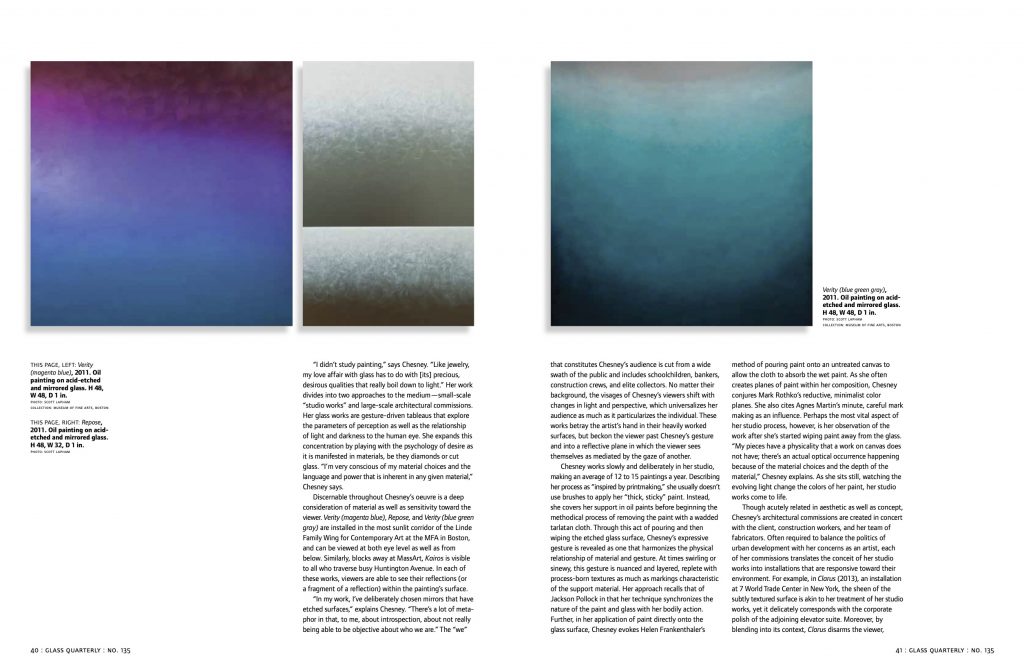

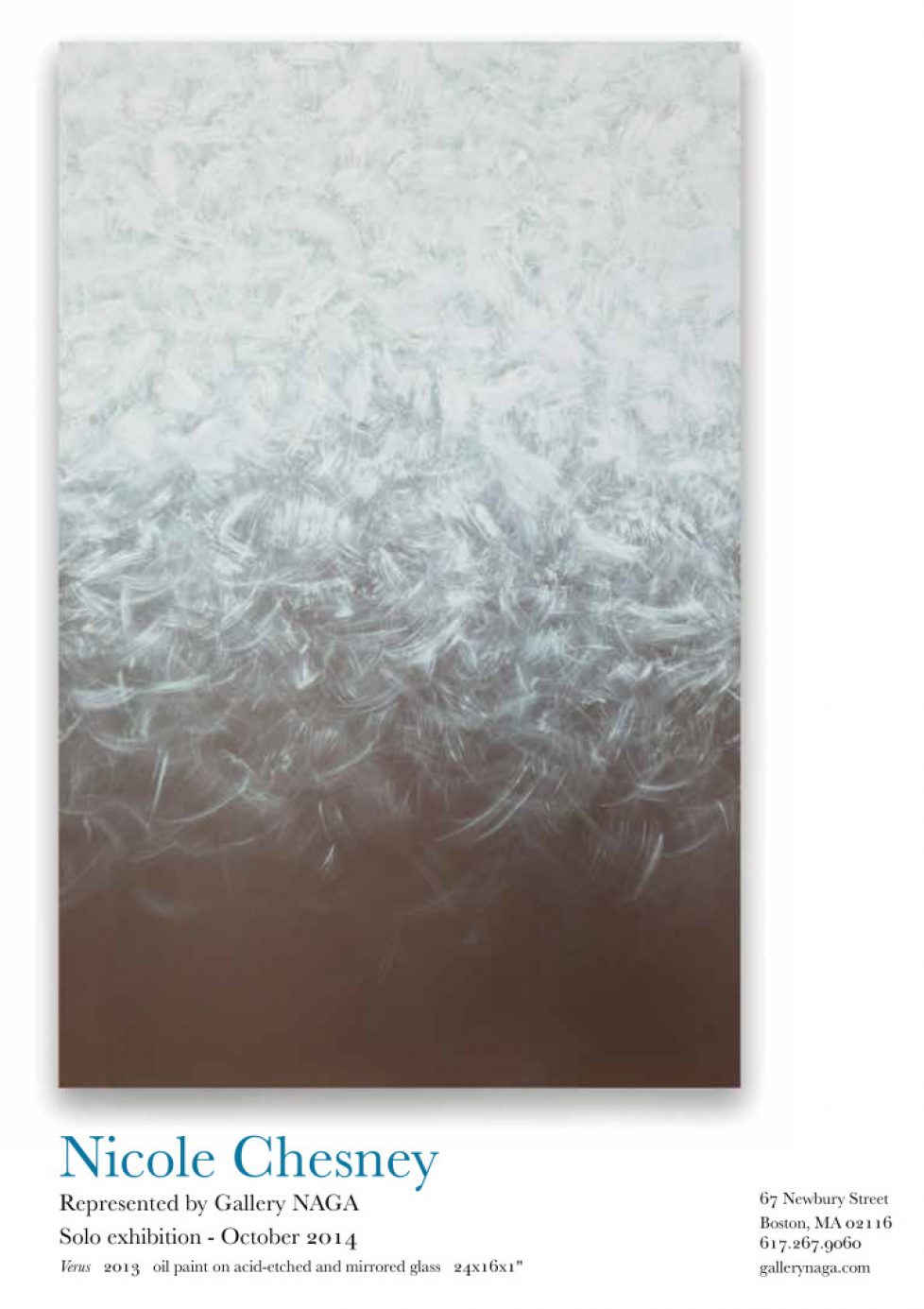
NAGA Gallery Solo Exhibition
NAGA Gallery Solo Exhibition

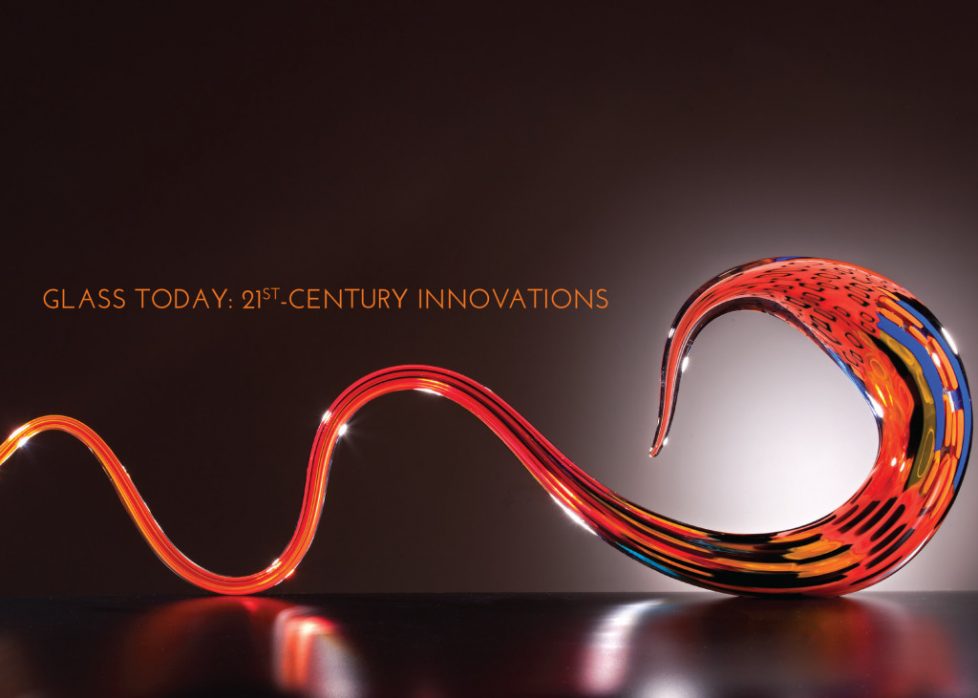
New Britain Museum of American Art
New Britain Museum of American Art


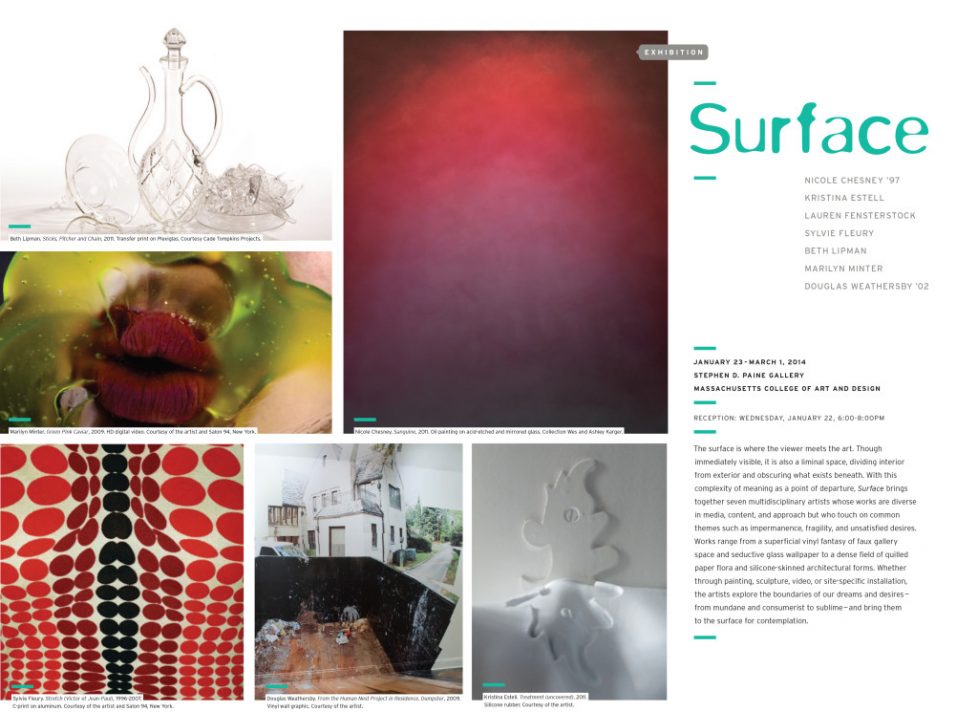
Surface Exhibition
Surface Exhibition


